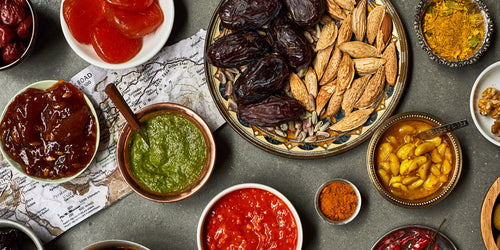Your Cart is Empty
Armenia is a country in Western Asia with fantastic food, from luscious minced meat lyulya kebabs flavored with cumin and dried oregano to plump manti dumplings sprinkled with Aleppo pepper and sumac. Armenians also specialize in a rich array of sweets, like Nazook and Gata, two pastries made of dough and streusel but shaped differently. “Gata is traditionally shaped round in a disk, so it’s like a really delicious frisbee that you shouldn’t throw, you should eat,” says Kristine Jingozian, an Armenian-American baker based in the San Fernando Valley of Los Angeles. From pilaf made with vermicelli to the thick meat porridge called harissa, and Jingozian’s own recipe for Lokhum (read: Turkish delight), Armenian food is well-worth learning about and cooking at home. All you need is a handful of essential ingredients to make these dishes come to life. But first, a little bit of history...

Jingozian is one of many Armenians living in Los Angeles, where the largest population of Armenians reside outside of the Caucasus nation. The first significant wave of immigration occurred as a result of the horrific Armenian genocide during World War I. Subsequent periods of political unrest, including for Iranian-Armenians and Egyptian-Armenians, combined with the loosening of immigration laws were the catalyst for the Armenian-American community’s expansion in southern California. Today, well over 150,000 Armenians have settled in L.A.—about 40% of the Armenian-American population in the U.S. Still, it’s a small-sized immigrant group compared to others in the U.S., which means few Americans have been exposed to Armenia’s aromatic and nuanced cuisine. With influences from Europe and Levantine cuisines, Armenian food centers fresh and dried herbs, vegetables, cultured dairy, meat, lavash (flatbread), and a tight selection of spices like cumin and sumac. Staple pantry items include bulgur, legumes, nuts, fresh and dried fruit like apricots and cherries, and grape leaves.
A look inside Rose + Rye, the popular microbakery Jingozian runs with her sister, Rose, is a lesson in Armenian heritage through sweets. The duo started the project in the height of the pandemic when income from Farine, the fancy custom cake company they run with their mother, had dried up, and everyone everywhere was in need of some comfort. “I thought about the things that used to make me feel good, which were what I used to eat at grandma's house,” she remembers. They started experimenting with (and eventually selling) traditional rustic treats, like nazook—a pastry made of yeasted puff pastry filled with streusel, then rolled up and sliced into dense rectangles with rounded edges—and Persian halva, fudgy stovetop shortbread flavored with cardamom and rose or saffron and pistachio. The Jingozian sisters learned to make halva from their Iranian-Armenian maternal grandmother, while their nazook stems from a recipe shared by their uncle’s mother-in-law. They’ve reworked the latter quite a bit, including incorporating non-traditional flavors like black sesame and matcha in addition to the more classic vanilla and brandied date and walnut. Now people come from all over Los Angeles and as far as Irvine and Santa Barbara for a freshly baked dozen.

“I’ve pulled influences from a lot of different family members. When they say it takes a village, it really does,” Jingozian says. So it was their paternal grandmother who taught them lokhumlu, snowy crescent shaped shortbread cookies filled with homemade Turkish delight, which you should try making yourself.
Now that they’ve garnered a devoted fan base, Jingozian wants to “push a little deeper into traditional Middle Eastern flavors,” such as rose water, saffron, orange blossom water, and cardamom, which shine through in their halva and Persian Love Cake. The ultimate goal is to expose more people to authentic Middle Eastern sweets, so that consumers’ understanding of certain flavors aren’t tied to twists on French pastries, like pistachio croissants or rose cream puffs. Since a large portion of professional bakers are classically trained, “there’s rarely any representation of the original pastry that that flavor comes from,” Jingozian says. They’re also in the process of testing out vegan and gluten-free versions of Rose + Rye staples so they can be enjoyed by as many people as possible. And along with her mom and sister, Jingozian has been scouting spaces for a brick-and-mortar. If Rose + Rye is able to set down roots somewhere between the westside of Los Angeles and the valley, their dream of making Armenian pastries more accessible to all just might come true.

Below are Kristine Jingozian’s go-to Snuk items — an array of unique ingredients to try your hand at making traditional treats or incorporate into your own creations.
Rose + Rye’s Armenian Baking Essentials
- Honey Comb — Used as a decorative topping for Jingozian’s ten-layered medovik (read: Russian honey cake).
- Rose Water — A common ingredient in Armenian and Middle Eastern pastries.
- Candied Rose Petals “These blew me away, so beautiful,” Jingozian says.
- Honey — An obvious essential for richly flavored honey cake.
- Orange Blossom Water — In addition to rose water, orange blossom water is key for achieving a heady floral aroma.
- Medjool Dates — Whereas a typical type of nazook is made with cinnamon and walnuts, Jingozian adds brandied dates to her recipe to make it extra special.
- California Raw Pistachios — Pistachios are paired with saffron for utterly unique Persian halva.
- Whole Green Cardamom — Jingozian always grinds her cardamom fresh before incorporating it into baked goods, “so it smells really nice and fragrant.”
- Sadaf Tea Blend with Cardamom — This cardamom-infused black tea is Jingozian’s go-to drink (and it goes great with pastries).
- Red Rose Buds — To add rosy accents to sweets and for decorative purposes.
Get Cooking with Jingozian's Recipe for Armenian Lokhum (Turkish Delight)

Click here for Jingozian's Lohkum Recipe




